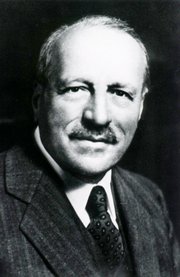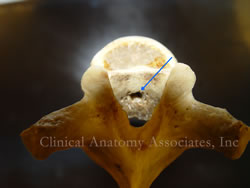
Medical Terminology Daily (MTD) is a blog sponsored by Clinical Anatomy Associates, Inc. as a service to the medical community. We post anatomical, medical or surgical terms, their meaning and usage, as well as biographical notes on anatomists, surgeons, and researchers through the ages. Be warned that some of the images used depict human anatomical specimens.
You are welcome to submit questions and suggestions using our "Contact Us" form. The information on this blog follows the terms on our "Privacy and Security Statement" and cannot be construed as medical guidance or instructions for treatment.
We have 379 guests online

Georg Eduard Von Rindfleisch
(1836 – 1908)
German pathologist and histologist of Bavarian nobility ancestry. Rindfleisch studied medicine in Würzburg, Berlin, and Heidelberg, earning his MD in 1859 with the thesis “De Vasorum Genesi” (on the generation of vessels) under the tutelage of Rudolf Virchow (1821 - 1902). He then continued as a assistant to Virchow in a newly founded institute in Berlin. He then moved to Breslau in 1861 as an assistant to Rudolf Heidenhain (1834–1897), becoming a professor of pathological anatomy. In 1865 he became full professor in Bonn and in 1874 in Würzburg, where a new pathological institute was built according to his design (completed in 1878), where he worked until his retirement in 1906.
He was the first to describe the inflammatory background of multiple sclerosis in 1863, when he noted that demyelinated lesions have in their center small vessels that are surrounded by a leukocyte inflammatory infiltrate.
After extensive investigations, he suspected an infectious origin of tuberculosis - even before Robert Koch's detection of the tuberculosis bacillus in 1892. Rindfleisch 's special achievement is the description of the morphologically conspicuous macrophages in typhoid inflammation. His distinction between myocardial infarction and myocarditis in 1890 is also of lasting importance.
Associated eponyms
"Rindfleisch's folds": Usually a single semilunar fold of the serous surface of the pericardium around the origin of the aorta. Also known as the plica semilunaris aortæ.
"Rindfleisch's cells": Historical (and obsolete) name for eosinophilic leukocytes.
Personal note: G. Rindfleisch’s book “Traité D' Histologie Pathologique” 2nd edition (1873) is now part of my library. This book was translated from German to French by Dr. Frédéric Gross (1844-1927) , Associate Professor of the Medicine Faculty in Nancy, France. The book is dedicated to Dr. Theodore Billroth (1829-1894), an important surgeon whose pioneering work on subtotal gastrectomies paved the way for today’s robotic bariatric surgery. Dr. Miranda.
Sources:
1. "Stedmans Medical Eponyms" Forbis, P.; Bartolucci, SL; 1998 Williams and Wilkins
2. "Rindfleisch, Georg Eduard von (bayerischer Adel?)" Deutsche Biographie
3. "The pathology of multiple sclerosis and its evolution" Lassmann H. (1999) Philos Trans R Soc Lond B Biol Sci. 354 (1390): 1635–40.
4. “Traité D' Histologie Pathologique” G.E.
Rindfleisch 2nd Ed (1873) Ballieres et Fils. Paris, Translated by F Gross
"Clinical Anatomy Associates, Inc., and the contributors of "Medical Terminology Daily" wish to thank all individuals who donate their bodies and tissues for the advancement of education and research”.
Click here for more information
- Details
This article is part of the series "A Moment in History" where we honor those who have contributed to the growth of medical knowledge in the areas of anatomy, medicine, surgery, and medical research.
Leonardo Botallus (c.1530- ??) Italian anatomist and physician,Leonardo Botallus (also known as Botalli, Botallo, or Botal) was born circa 1530 in the region of Piedmont. Botallus studied medicine at the italian university of Pavia, where he was a student under Gabrielle Fallopius. Botallus graduated circa 1553. He was an avid advocate of bloodletting, causing him to direct his anatomical studies towards the subject of the vascular system. Although he did not discover the foramen ovale and the ductus arteriosus, he mentions these structures by those names in both his posthumous publications " De via sanguinis a dextro in sinistro cordis ventriculum" (1640) and "Opera Omnia Medica et Chirurgica" (1660)
In France Botallus became physician to King Charles IX. Not much more is known about Botallus, and history fails to record his date and place of death, as well as his image. The image depicted here is from his 1660 publication. Click on the image for a larger depiction.
Botallus' name is eponymically remembered in the following structures:
- Foramen of Botallus: The foramen ovale, an opening found in the fetus in the region of the fossa ovalis that closes upon birth
- Duct of Botallus: A communicating vessel between the left pulmonary artery and the proximal region of the descending aorta, part of fetal circulation, also known as the ductus arteriosus
- Ligament of Botallus: The closed ductus arteriosus in the adult
Sources:
1. "History of medicine; a correlative text, arranged according to subjects" Mettler, C Ch. 1947 The Blakiston Co
2. "Stedmans Medical Eponyms" Forbis, P; Bartolucci, SL. Williams & Wilkins 1998
3. "The origin of Medical Terms" Skinner, AH, 1970
4. "The First Closure of the Persistent Ductus Arteriosus" Alexi-Meskishvili,V; B?ttcher, W. Ann Thorac Surg 2010;90:349 –56
NOTE: There is no known image of Botallus. Skinner's "Origin of Medical Terms" shows one, but we could not confirm the origin of the image. If you know or have one, let us know!
- Details
This term arises from the Latin [lumbus] meaning "loin". The "loins" region of the body is the area lateral to the umbilicus, wrapping around posteriorly. In fact, there are two abdominal regions known as the "lumbar regions".
Galen of Pergamon(129AD - 200AD) named and described the lumbar vertebrae.
- Details
[UPDATED] The basivertebral foramen is an opening in the posterior aspect of each vertebral body (click on the picture for a larger image) which allows the exit of the basivertebral veins. These foramina can be single (as seen in the image) or multiple. The basivertebral veins represent a communication that allows drainage of the vertebral body venous sinuses into the extensive complex venous network of the internal venous plexuses that surrounds the spinal cord.
The plexus of veins around the spinal cord are known as Batson's plexus. this plexus is named after Oscar Vivian Batson (1894 - 1979), an American anatomist and ENT.
Image property of: CAA, Inc. Photographer: David M. Klein
- Details
[UPDATED] Latin words meaning "oval fossa" or "oval depression". The fossa ovalis is, as it names implies, an oval-shaped depression in the interatrial wall of the right ventricle. (see image, pointer "A"). The fossa ovalis represents in the adult the fetal communication between the right and left atrium allowing for fetal oxygenated blood to bypass the pulmonary circulation and enter the systemic circulation directly. The fossa ovalis is closed upon birth by two opposing membranes, and the higher pressure on the left side of the heart.
The persistence of the communication between the right and left atrium is known as an Atrial Septal Defect (ASD) and will need surgical correction. Some anatomists refer to this depression as the "foramen ovale" and it is surrounded by a well-defined muscular border known as the "limbus fossa ovalis", also known by the eponym "ring or anulus of Vieussens"
The interatrial opening in the fetus, and the persistent ASD in the adult is referred by the eponym "foramen of Botallus, remembering Leonardo Botallus.
The image shows a human heart with the right atrium opened. The black arrow points to the depression of the foramen ovale in the adult.
For more information:
• On fetal circulation
• On the fossa ovalis (Gray's Anatomy)
Image property of: CAA, Inc. Photographer: David M. Klein
- Details
This root term is Greek and means "diaphragm", referring specifically to the respiratory diaphragm. Because of the importance to life of the region that includes the respiratory diaphragm, liver, and heart, Greek and Roman physicians saw this area as the seat of emotions, a concept that later evolved to include mental instability, and mind. So, for them the seat or location of the emotional processes was not in the brain, but in the area of conjunction of liver, heart, and respiratory diaphragm.
In the late 1700's, when Franz J. Gall developed a pseudoscience that looked at protuberances in the cranium as predictors of mental capabilities and mental pathologies, he named it [phrenology], or "study of the mind". In fact, look at the word "frenzy" and you will see a variation of the root [-phren-] in it!
Today we use the root term [-phren-] mostly to denote "respiratory diaphragm", although it can be found in medical words such as [schizophrenia] meaning "mind".
- Details
This article is part of the series "A Moment in History" where we honor those who have contributed to the growth of medical knowledge in the areas of anatomy, medicine, surgery, and medical research.

George Papanicolaou, MD, PhD
George Papanicolau, MD, PhD (1883 - 1962) Greek physician, cytologyst, physyiologist, and zoologist, Papanicolaou was born on the island of Euboea, Greece. His original Greek name is Georgios Nikolaou Papanikolaou. He initially attended the University of Athens, earning his MD in 1904.
After two years as a conscript in the Army, Papanicolaou continued additional studies in Zoology earning his PhD in 1910 at the University of Munich, later going back to the army as a physician.
Papanicolaou immigrated to the USA in 1913 with his wife. He took a position at the anatomy department of the Cornell University where over the next 45 years established the field of diagnostic cytology, becoming a Professor Emeritus of Clinical Anatomy.
His studies took him to study the cytological patterns in the internal genitalia of guinea pigs, establishing a “cytological calendar”. This study he continued in humans, where he discovered malignant changes in some of the cells obtained. His study on vaginal smears was published in 1943, starting what today is known as a “Pap smear”, a simple annual study that saves thousands of women from cervical and uterine cancer.
Dr. Papanicolaou died in 1960. His personal motto was “I live to serve life”
Sources:
1. “George Nicholas Papanicolaou, 1883-1962” Owens, C. Endoc T 2008:6(5) 28
2. "George N Papanicolaou (1883-1962) MD" Frangos, CC. J Me Biog 17 (3) 134
3. "George N. Papanicolaou, MD, PhD" Elgert, P A; Lab Med (2009) 40;4 245
4. "The diagnostic value of vaginal smears in carcinoma of the uterus" Papanicolaou, GN; Traut HF; Amm J Obst Gyn 1941; 42:193-206.




